How Elements of Ancient Greek Culture Continue in the Western World Today
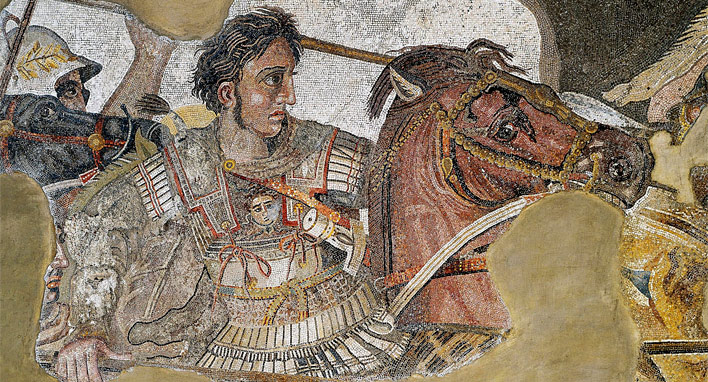
The Journey of Classical Greek Culture to the West
By Hafeez Diwan and Sally Mallam
Contributing Writers
The cultural center of what would become our Western heritage moved from Rome and Constantinople to cities in the Islamic world, the most famous of which were Baghdad and Cordoba. Islamic culture favored learning and tolerance, two major factors that set the stage for the Arab "Golden Age," which contributed to the birth of the European Renaissance.
"There are more paths from ancient Greece to the modern world than the route leading through the Roman west." (Carol G. Thomas, ed., Paths from Ancient Greece, Leiden, The Netherlands: E.J. Brill, 1988, p. 1)
Through the deliberate spread of Greek culture, Alexander the Great hoped to forge common links between the diverse regions and peoples of his expanding empire. His conquests included most of the then-known world sprawling over three continents, from Greece down to northern Africa, to Asia Minor and across western Asia to the Indian subcontinent.
Greek influence continued after Alexander's death in 323 BCE with the Hellenistic kingdoms that followed and flourished until the emergence of the Roman Empire in 31 BCE. During this pre-Roman period, Greek languages, Greek ways of thinking, and the most important Greek writers were introduced to the many non-Greek populations who absorbed them into their own cultures: Egyptian, Iranian, Bactrian, Indian and Phoenician peoples, among others.
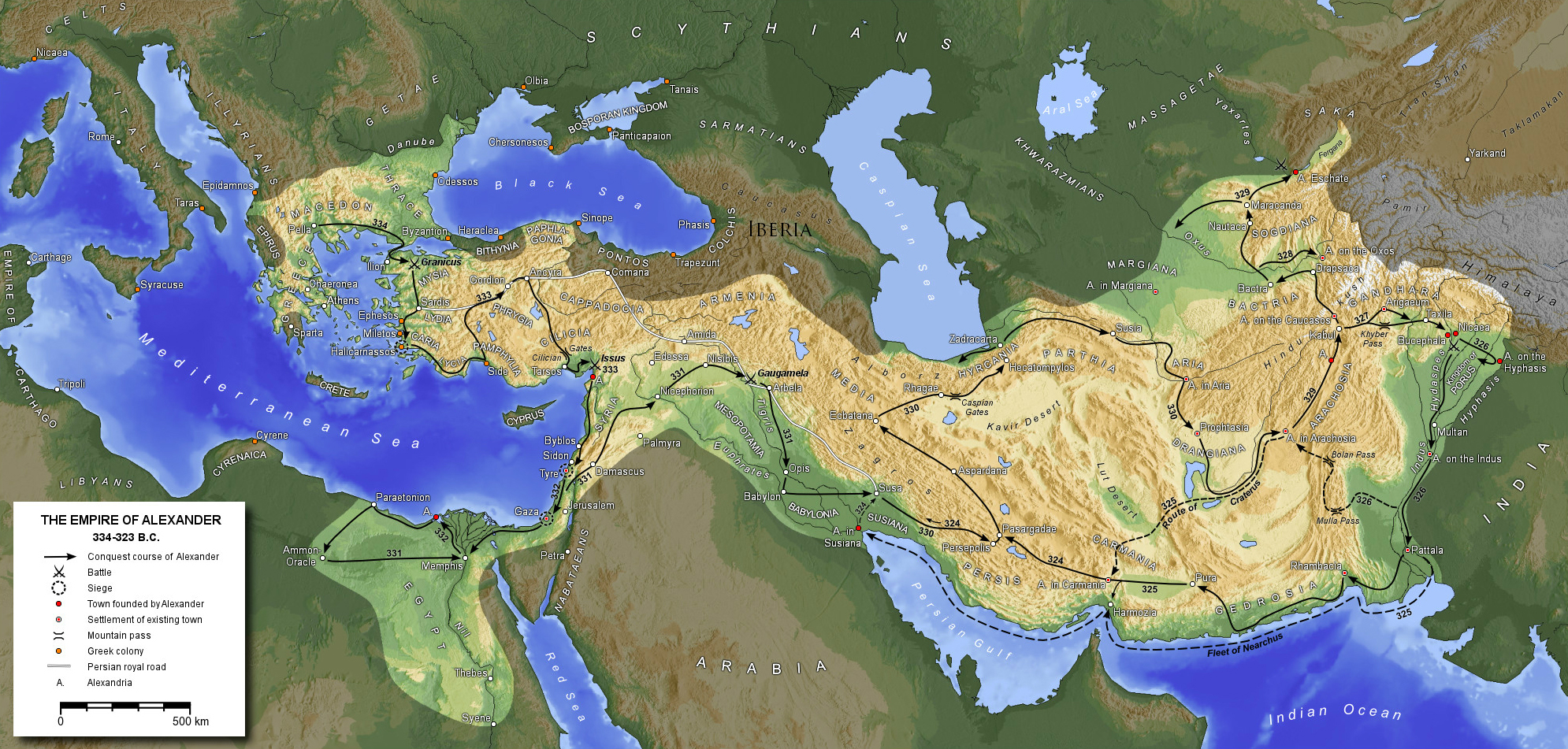
The Egyptian port city of Alexandria was envisioned by Alexander in 332 BCE. Sadly, he died before he could begin work on the city that, according to his plan, would hold all the world's knowledge. In the end it was his friend and trusted general Ptolemy – like Alexander a former student of Aristotle – who established Alexandria as a metropolis of culture and wealth.
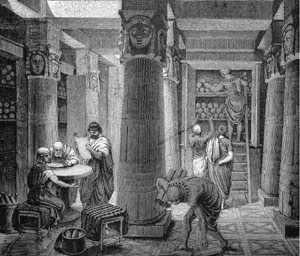
Artistic Rendering of the Library of Alexandria, based on some archaeological evidence.
The famous Great Library of Alexandria, built circa 288 BCE by Ptolemy I (Soter), became the world's center for scholars and scientists. According to Theodore Vrettos in his book Alexandria: City of the Western Mind, "It has never been revealed how the Library functioned, or if its scholars and scientists lived on the premises. … However, one fact is certain: they indeed engaged in scholarly work of immense value, which was intimately connected with the Great Library that stood on their premises. Books and papyrus rolls were collected from every corner of the civilized world, with the aim of gathering together the writings of all men so far as they were worthy of attention. This massive collection of books and scrolls was not limited to Greek and Roman works, Oriental writings were translated into Greek and placed in the Library; as were ancient Egyptian texts, the Hebrew Scriptures, and writings ascribed to the Persian prophet Zoroaster."
In the third and second centuries BCE, Alexandrian Jews translated the Old Testament into Greek, a version that became known as theSeptuagint. At one time there were said to have been around 70,000 papyrus scrolls housed in the Alexandrian library, including works that were confiscated from ships entering the city's harbor. No one really knows the exact number. The library's destruction is attributed to two fires that got out of control: one set by Julius Caesar in order to escape the Egyptian fleet in 48 BCE; and the second set by the Emperor Theodosius, who in 391 CE, as part of a campaign to eradicate pagan worship, commanded the destruction by fire of the pagan Temple of Serapis. Most historians agree that the library was finally and completely destroyed by Christian fanatics some three centuries before Egypt was conquered by the armies of Islam.
Greek Legacy and the Roman Empire
When Greece fell to the Romans in 146 BCE, the Roman Empire became the first post-Greek culture to inherit the wisdom of the Greek philosophers. The Romans honored Greece as the source of not only their culture, but also their religion and civilization. In west and central Mediterranean countries, the heritage of Greece was incorporated into Roman culture and modified. As an example typical of the ancient world, characteristics of Greek gods were attributed to and absorbed into their Roman equivalents: Apollo was taken into the Roman pantheon with no name change, Jupiter took on traits from Zeus, Neptune took on traits from Poseidon, and so on.
In the fourth and fifth centuries CE, as orthodox Christianity became established, attitudes changed toward the classical Greek thinkers. The primacy of the Christian church meant that education was devoted to the spread of orthodox Christian thinking and biblical studies, leaving no place for critical thinking or discourse. In 398 CE, the Fourth Council of Carthage prohibited the reading of secular works by bishops. Major figures of the time, although conversant with the classics, were persuaded not to endorse them. St. Jerome (340–420 CE) denied their validity "except for pious ends" though St. Augustine (354–430 CE) believed that philosophical reflection complemented theology. The scholar Sheila Dunn notes that to Augustine, "true philosophy was not possible without both faith and reason and, consequently, there was no distinction between philosophy and theology. Augustine believed that all wisdom was Christian wisdom and all of his writings are concerned with defending or explaining Christianity."
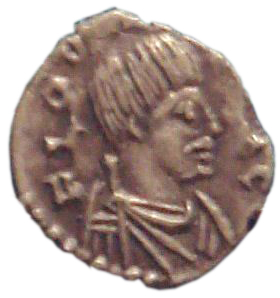
Coin of Odoacer, Ravenna, 477, with Odoacer in profile, depicted with a "barbarian" mustache.
As northern tribes – first the Visigoths and then the Vandals – moved into Roman territory, the Roman empire weakened. In 476 CE, the western part of the empire collapsed, overthrown by the Ostrogoth Odoacer and his "barbarian" (a term that originally meant "non-Greek") armies. By the time Boethius (480–524 CE) was appointed Roman consul, the Italian peninsula was ruled by the Ostrogoths. Like all members of the Roman aristocracy of his day, Boethius was a Christian, yet he is known today as the "last of the Roman philosophers and the first of the scholastic theologians." He spoke fluent Greek and intended to translate all the works of Aristotle and Plato from the original Greek into Latin. Before his untimely death by execution, Boethius succeeded in translating Aristotle's logical works. After Boethius' death, many of his translations disappeared. Only his translations of Aristotle's Categories andOn Interpretation ever got into general circulation before the twelfth century.
The Celtic monasteries of Ireland helped preserve pagan and Christian writings in both Greek and Latin. For at least 50 years, starting in the mid-sixth century CE, Irish monks sent missionaries to Britain, France and Spain to seek out, study and copy manuscripts, whether Christian or pagan. Under the leadership of Charlemagne, Greek classical works were copied and studied by scholars such as the Carolingian masters Alcuin, Clement, and John Scottus Eriugena, the latter considered the most significant Irish intellectual of the early monastic period. But all in all, too much was lost, and what wasn't lost was largely ignored by minds too focused on Christian teachings, to the detriment of the ancient classics.
By the end of the sixth century, first-hand knowledge of Greek had died out, leaving very few Latin translations of works from ancient Greece. Learning took place in isolated outposts and monastic sanctuaries. The monastic life attracted some of the best minds of the time. Within monastery walls, ancient manuscripts, mostly religious but occasionally secular, were preserved and copied. Unfortunately, as Rubenstein points out in Aristotle's Children, the wisdom of classical texts was ignored. "For the next five centuries, they are copied and recopied by monks who hardly know what they are preserving, or why."
The Eastern Roman Empire and Byzantium
In 330 CE Emperor Constantine I moved the Roman capital to Byzantium, which he renamed Constantinople ("Constantine's city"). The eastern half of the Roman Empire was geographically more secure than the western half. Emperors in the eastern half exerted control over a well-administered, politically stable region that was far more affluent than other states of the early medieval period.
There, Hellenism survived to become the foundation of the predominantly Greek-speaking Byzantine empire. Throughout Byzantium, monuments and texts of classical Greece were preserved, copied, and stored in monastic and private libraries. But after centuries of centralized imperial rule, Byzantine thinkers tended to follow imperial pronouncements, which emphasized orthodox Christianity above all else. Reading philosophical treatises was permitted, but their content and the act of reading them came under criticism. Eventually the "pagan" texts of Plato, Aristotle and others were permitted, provided they could be interpreted as supporting the Christian faith.
Plato's original Academy had been destroyed in 86 BCE by the Roman dictator Sulla. Centuries later in 410 CE, a Neoplatonic Academy was established that served as a center for Neoplatonism and mysticism. Historians, such as Norman F. Cantor note that it was shut down in 529 CE by the Emperor Justinian I "effectively shutting off the intellectual pursuits of the non-Christian professors located there and forcing the leading members of the Academy to relocate. The Byzantines had come to regard philosophy as an alien science: not as a part of the Greek heritage that served the true, Christian wisdom but as a discipline exterior and even irrelevant to it. . . . efforts to combine philosophy and theology were no longer welcome in Byzantium."
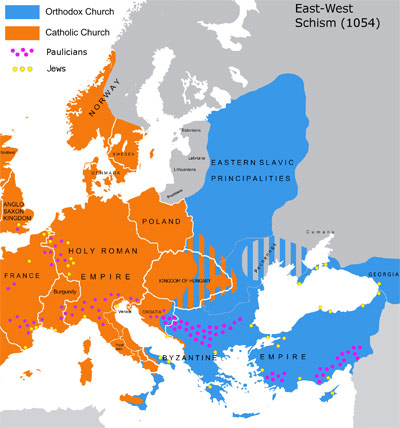
From the fifth century to the eleventh century CE, communication between East and West was disruptive and disrupted by the adversarial nature of the relationship between the Latin and Greek churches and their growing estrangement. "The theological genius of the East was different from that of the West. The Easterntheologyhad its roots in Greekphilosophy , whereas a great deal of Western theology was based onRoman law . This gave rise to misunderstandings that gradually led to two widely separate ways of regarding and defining one important doctrine—the procession of theHoly Spiritfrom the Father or from the Father and the Son. The Roman churches, without consulting the East, added 'and from the Son' (Latin:Filioque ) to theNicene Creed. Also, the Eastern churches resented the Roman enforcement of clericalcelibacy , the limitation of the right of confirmation to thebishop , and the use of unleavened bread in theEucharist ." (Britanica.com). In 1054 CE, the Church of Rome finally separated from the Greek Orthodox Church in what became known as the "East-West Schism."
As already mentioned, works from ancient Greece were rare in the West and their use so restricted in the East that they have been described by scholars as being little more than museum pieces. Given this and the lack of communication between the two regions, it is certain, as Arthur Herman says in The Cave and the Light, that "without Arab help, western Europe would never have recovered its knowledge of Greek science and mathematics – still the foundations of modern science today – or understood how to interpret it."
From Rome to Baghdad – The Golden Age of Islam
Rome's decline, followed by the disastrous Byzantine wars with Persia, left a vacuum into which the Muslim invaders stepped, taking over the land and ideas of the peoples they conquered, including their accumulated resources of Greek literature, philosophy and sciences. For the first time since Alexander the Great, and for a much longer period, Arab conquests enabled the reunification of territories such as Egypt and the Fertile Crescent with Persia and India politically, administratively and, above all, economically.
The expansion of the Arab Empire in the years following the Prophet Muhammad's death in 632 CE led to the creation of caliphates occupying vast geographical areas. By the end of the seventh century CE, the Umayyad Caliphate's armies had swept across North Africa. In 711, under general Tariq Ibn Ziyad, they crossed over into Spain. Arab expansion beyond France was halted by Charles Martel at the Battle of Tours in 732. As Al-Khalili says in his definitive work The House of Wisdom, "By this time the Islamic Empire covered an area larger in expanse than either the Roman Empire at its height or all the lands conquered and ruled by Alexander the Great."
The cultural center of what would become our Western heritage moved from Rome and Constantinople to cities in the Islamic world, the most famous of which were Baghdad and Cordoba. In 750 the Abbasids overthrew the Umayyad Dynasty, and in 762 they moved the capital of the Islamic world from Damascus to Baghdad. During the reigns of the Abbasid Caliphs al-Mahdi and his son, the Caliph Harun Al-Rashid (the same Caliph who figures in many stories of the Arabian Nights), Baghdad became the magnet for the greatest intellects of the time. It was home not only to Muslims but to Christians, Jews, Hindus and Zoroastrians, attracting immigrants from the Middle East, Central Asia, Spain and beyond.
Islamic culture favored learning and tolerance, two major factors that set the stage for the Arab "Golden Age." The Prophet Mohammed whose sayings were well-known in the Muslim world is on record as encouraging learning. For example: "The ink of the scholar is holier than the blood of the martyr." " The pursuit of knowledge is obligatory on every Muslim." "Seek knowledge even as far as China." Mohammad saw himself not as bringing the world a new faith, but as the last of the prophets in a "chain of transmission" that included Abraham, Moses and Jesus. Accordingly, the "People of the Book" merited protection and respect. Tolerance is fundamental to Islamic teaching; without tolerance, it is unlikely that there could have been the convivencia (coming together) that led to the intellectual and scientific flowering that would later be imported and incorporated into western culture.
Under Arab rule, scholars applied themselves directly to original Greek sources or to translations of them. Most of the first translations into Arabic were made by Christians from the many Greek books that were already extant in Iraq in Syriac translations. Greek texts were brought to Baghdad from Syria, Bactria, India, Persia and elsewhere. Translations might be made several times, each version correcting errors in previous translations as the content became better understood.
The transmission, processing and amplification of knowledge included translations of Sanskrit and Persian works. By the seventh century, Muslims came into direct contact with the surviving Hellenistic cultures of the Near East, connecting, for example, with Christian Syriac writers, scholars and scientists, and later with sources in the central and western Mediterranean.
From about the middle of the eighth century to the end of the tenth, almost all non-literary and non-historical secular Greek books – including philosophical works – that were available throughout the eastern Byzantine Empire and the Near East were translated into Arabic, which became the second classical language, after Greek.
The Arabs were not passive caretakers who merely held Greek knowledge for later transmission to the West. Rather, they took it and developed it further, in massive state-run enterprises that were carried out by some of the brightest minds in history. In effect, Arab civilization at its peak achieved what the Arabic inscription on the wall of King Abd ar-Rahman's Great Mosque in Cordoba says: "It embodied what came before. Illuminated what came after."
The House of Wisdom and the Translation Movement
"The Graeco-Arabic translation movement of Baghdad constitutes a truly epoch-making stage, by any standard, in the course of human history. It is equal in significance to, and belongs to the same narrative as, I would claim, that of Pericles' Athens, the Italian Renaissance, or the scientific revolution of the sixteenth and seventeenth centuries, and it deserves so to be recognized and embedded in our historical consciousness."(Dimitri Gutas, Greek Thought, Arabic Culture)
The translation movement really took wing when, in the eighth century, an academy called the House of Wisdom (Bayt al-Ḥikmah) was established by Harun al-Rashid's son, Abu al-Abbas Abdallah ibn Harun al-Rashid, better known by his regnal name al-Ma'mun. It's not known whether there really was a single physical House of Wisdom or multiple locations, but there was certainly an institution by that name. Al-Ma'mun was a great patron of science and scholarship, and went to considerable lengths to acquire Greek, Indian and Persian texts – including those by Aristotle, Euclid and Ptolemy – and have them translated into Arabic.
The explosion in translation activity was the result of a combination of factors, including the lifting of both political and religious barriers between the East and the West. Scholars and experts from many countries, fields and cultures were able to contribute, learn and work together. A tremendous interest in Persian knowledge stimulated the translation of Persian texts into Arabic. Al-Ma'mun was half-Persian, and his Persian tutor, Jafar, instilled in his pupil a love for learning. There was a focus on astrology, not only because of Al-Ma'mun's personal interest in it, but also because he knew that he needed the support of the Persian aristocracy, and astrology was, as Al Khalili says, "embedded in the Persian culture, and played a fundamental role in Persian daily life." Interest in it led in part to an interest in other sciences; astrology did not begin its demotion from the Arab scientific worldview until the mid-ninth century.
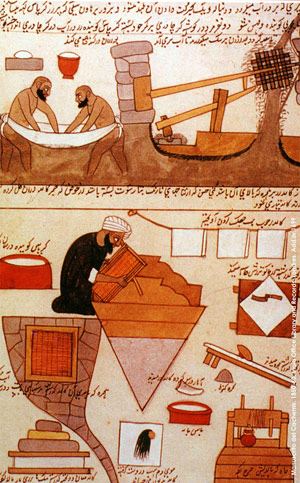
The most significant contribution to this amazing translation period was the introduction of paper from China.
The most significant contribution to this amazing translation period was the introduction of paper from China. Prior to that time, Arabs and Persians used the more cumbersome and expensive papyrus or parchment made from the skin of animals. Samarkand, a Central Asian center of learning in the Persian Empire, continued to be a center of learning under the Abbasids. When the Chinese were defeated by the Muslim army in 751, Chinese prisoners of war with knowledge of papermaking were taken back to Samarkand. Situated along the Silk Road between China and the West, Samarkand was the site of the first paper mill of the Abbasid Empire. By the end of the eighth century, Baghdad had paper mills, and an entire street in Baghdad's city center was devoted to the sale of paper and books. Less expensive than papyrus or parchment, paper was a vital element in the efficient growth of the Empire's expanding bureaucracy.
By the ninth century Baghdad was the largest city in the world with dozens of multi-storied elaborate palaces for the Caliph, his family and their entourage, as well as libraries, administrative buildings, broad avenues, boulevards, and gardens. Complex canals carrying water into the city from the Tigris ensured adequate irrigation and water for all purposes. Construction projects made mathematical knowledge essential, as were astronomical studies, since they provided both the direction of Mecca to which all Moslems pray five times a day and the times for those daily prayers, plus they accurately determined the beginning and end of Ramadan, the month of fasting.
The end result of the confluence of these factors was that in Caliph Al-Ma'mun's time, the translation movement became a truly massive undertaking by people of multiple faiths, one in which tolerance trumped religious affiliations in favor of learning. To quote Al-Khalili's The House of Wisdom again, "The greatest of all the translators of Baghdad, Hunayn ibn Ishāq, was a Nestorian who never converted to Islam. Other Christian scientists of ninth-century Baghdad include the astronomer Yahya ibn abi Mansūr and the physicians Jibrīl ibn Bakhtyashū and Ibn Massāwayh. Likewise, many Jewish philosophers and scientists, such as the translator Sahl al-Tabari, the medic Ishāq ibn Amrān and the astronomer Mashā'allah, all made valuable contributions to the intellectual culture of Baghdad."
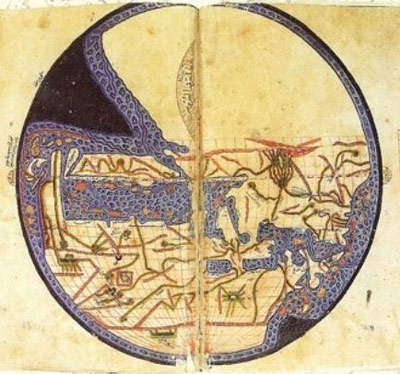
The world map of Caliph al-Ma'mun oriented with South at the top. (Topkapi Museum, Istanbul)
Al-Ma'mun favored the Mu'tazilites, who sought to combine faith and reason and encouraged a spirit of scientific inquiry. He was very likely the first head of state in history to bring together a diverse group of scientists with expertise in mathematics, astronomy and geography, working together at the first astronomical observatory in the Islamic world. There they checked Ptolemy's astronomical tables, made their own observations and produced a new set called the "Verified Tables." Al-Ma'mun commissioned scientists to determine an accurate value for the circumference of the Earth. (The conclusion was 24,500 miles, very close to the correct value of 24,901 miles. Eratosthenes, a Greek who lived from around 275 BCE to 195 BCE, got even closer, with a value of 24,900 miles, but some believe this was due to luck, since his method included guesswork.) Al-Ma'mun also ordered a mapmaking enterprise that would have a tremendous impact on the field of mathematical geography. His team of scientists came up with a map of the world that showed the locations of important cities and landmarks, correcting the geographical data in Ptolemy's Geographia.
The luminaries who contributed to the work of the House of Wisdom spoke several languages and were all polymaths, with their knowledge and abilities spanning many different fields. A few are listed below, with links to videos where possible to give an idea of their accomplishments, individual approach and effect on the modern world:
Muḥammad ibn Mūsā al-Khwārizmī (c. 780 – c. 850)
Al-Khwarizmi is the author of the first book on algebra, Kitab al-Jebr, which provided for the first time the principles and steps that could be used to solve certain algebraic equations. In fact, the word "algorithm" (the process or steps needed to solve problems) is derived from his Latin name: Algorithmus. Al-Khwarizmi's work The Hindu Art of Reckoning played a crucial role in bringing the Hindu-Arabic numerals into widespread use in Europe, where they transformed the study of mathematics and astronomy throughout the continent.
Other mathematicians of Islam's Golden Age further developed the field of algebra, including the Persian Omar Khayyam, a Sufi who was not only a mathematician (he was the first to write the complete theory of cubic equations) but also an astronomer, philosopher and poet, author of the famousRubaiyat.
Yaqub ibn Ishaq al-Kindi of Basra (805–873; Latin name Alcindi)
Al-Kindi supervised the translation of numerous texts from Greek to Arabic; he was known as the "Philosopher of the Arabs," but also wrote on mathematics, geography, music, medicine, astronomy and even cryptography, among other disciplines. Al-Kindi applied philosophical thinking to Islam, emphasizing the importance of studying Aristotelian philosophy and not rejecting it, insisting that "We should not be ashamed to recognize truth and assimilate it…even though it may come from earlier generations and foreign peoples. For the seeker after truth there is nothing of more value than truth itself."
Al Farabi (870–950; Latin name Abunaser)
After Al-Kindi, Al-Farabi continued the work of assimilating Greek philosophy into Islamic thinking and, for his efforts, came to be known as "the Second Teacher," after Aristotle.
"Man is a part of the world, and if we wish to understand his aim and activity and use and place, then we must first know the purpose of the whole world, so that it will become clear to us what man's aim is, as well as the fact that man is necessarily a part of the world, in that his aim is necessary for realizing the ultimate purpose of the whole world. Therefore, if we wish to know the object toward which we should strive, we must know the aim of man and the human perfection on account of which we should strive." (Quoted by David C. Reisman, "Al-Farabi and the philosophical curriculum," in The Cambridge Companion to Arabic Philosophy, ed. Adamson and Taylor, 68-69)
Abu Bakr Muhammad ibn Zakariyya al-Razi of Persia (865–925; Latin name Rhazes)
Medicine was another field that saw great achievements. Al-Razi (known in the West as Rhazes) was the most famous physician of his time and was also a chemist and philosopher. He wrote the Kitab al-Hawi (Liber continens) and a monograph on smallpox and measles, which remained two of the most important works on medicine in Europe for several centuries. Al-Razi drew inspiration from the Greek greats Galen and Hippocrates, but he did so critically, even writing a book called Doubts about Galen, in which he questioned and critically evaluated some of Galen's ideas. He was an opponent of quacks and a champion of the scientific method, conducting one of the earliest clinical trials in history, in which he investigated whether bloodletting could treat meningitis.
In Baghdad, Al-Razi was treating patients with mental illness – at a time when the mentally ill in Christian Europe were viewed as possessed by the devil – earning him the accolade "father of psychology and psychotherapy." He was a pioneer chemist, moving away from the Greek philosophical meditations reflected in the work of his predecessor Jabir ibn Hayyan (known in the West as Geber the Alchemist). Al-Razi produced one of the earliest classifications of the chemical elements. He was a freethinker who once commented "If the people of religion are asked about the proof for the soundness of their religion, they flare up, get angry, and spill the blood of whoever confronts them with this question," and asked "How can anyone think philosophically while committed to old wives' tales, founded on contradictions, obdurate ignorance, and dogmatism?"
Abū Ali al-Hassan ibn al-Haytham (965 – c. 1040; Latin name: Alhazen)
In 969 CE Al-Hakim, one of the Fatimid Caliphate (Shia rulers who claimed their descent from Fatima, daughter of the Prophet Mohammed) built the city of Cairo. With the Al-Azhar Mosque and university at its heart, Cairo became another center of learning. The Arab polymath Abū Ali al-Hassan ibn al-Haytham went there from Basra in about 1000. He is regarded as one of history's greatest physicists, ranked between Archimedes and Isaac Newton. Al-Haytham's most famous work is Kitab al-Manazir (The Book of Optics) shaped our understanding of vision, optics and light.
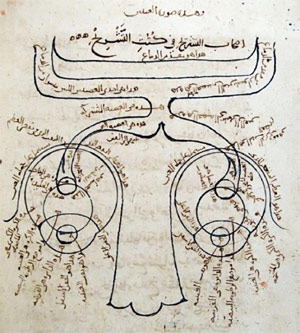
The structure of the human eye according to Ibn al-Haytham.
Al-Haytham worked on optics and astronomy, including the optics of vision (though he didn't carry his thinking far enough to show how the inverted image forms on the retina). Prior to him, it had been thought that vision required light being emitted by the eye, an idea he disproved with the help of observation and logic. Like others of his time, Al-Haytham was geocentric in his thinking, believing the Earth to be the center of the universe; nevertheless, his emphasis on the scientific method has led many to consider him the first true scientist. One of his seminal contributions was to ground astronomy in a mathematical foundation, emphasizing planetary motion in terms of mathematics alone, without recourse to any philosophy or ideology. Al-Haytham's stance on facts is evident: "The duty of the man who investigates the writings of scientists, if learning the truth is his goal, is to make himself an enemy of all that he reads, and … attack it from every side. He should also suspect himself as he performs his critical examination of it, so that he may avoid falling into either prejudice or leniency."
Abū Rayhān al-Bīrūni (973–c.1050; Latin name Alberonius)
Al-Biruni was a philosopher, astronomer, mathematician, anthropologist and geographer, and was the author of a great historical text, The Chronology of Ancient Nations, a book still regarded as one of the greatest sources of medieval history ever written. He spent much of his life in Ghazni, the capital of the Ghaznavid dynasty, in modern-day Afghanistan, and became court astrologer to Sultan Mahmud of Ghazni, whom he accompanied on invasions into India.
Al-Biruni found a way to measure the circumference of the Earth more accurately than it had ever been measured before, within one percent of the correct value, and he did so in a very clever way, as explained in The House of Wisdom (pp. 184-186). He also noted that the available evidence could be used to make a case for the Earth revolving around the sun just as much as for the reverse. Al-Biruni defended scientific thinking from the "extremist" who would "stamp out science as atheistic" so as to make "ignoramuses, hate the sciences" and lead to "complete destruction of science and scientists." With works on comparative religion and different cultures – for example, that of India where he studied Indian history and the Hindu faith – he is considered history's first anthropologist. Such was his prestige that the first half of the eleventh century was acknowledged as the "Age of Al-Biruni."
"The stubborn critic would say: 'What is the benefit of these sciences?' He does not know the virtue that distinguishes mankind from all the animals: it is knowledge, in general, which is pursued solely by man, and which is pursued for the sake of knowledge itself, because its acquisition is truly delightful, and is unlike the pleasures desirable from other pursuits. For the good cannot be brought forth, and cannot be avoided, except by knowledge. What benefit then is more vivid? What use is more abundant?" (Al-Biruni, quoted by Jim Al-Kalili in Pathfinders: The Golden Age of Arabic Science)
Abu Ali al-Husain ibn Sina (980–1037; Latin name Avicenna)
Ibn Sina is probably the most famous Islamic scholar in history, and is considered the father of modern medicine. His Canon of Medicine, a medical encyclopedia, was a standard textbook in both the Arab world and Europe for 600 years. Another famous work, The Book of Healing, dealt with science and philosophy and was influenced by Greek and Hellenistic thinkers as well as by earlier Persian and Arab scientists and philosophers, such as al-Biruni, Al-Farabi and Al-Kindi. Ibn Sina more than any other scholar, helped spread the ideas of Neoplatonism within the Islamic world. He was "in the Arabic culture the most effective promoter of Greek philosophy" (Laughlin, The Aristotle Adventure, 117). 600 years before Descartes' famous "I think therefore I am," Ibn Sina argued that consciousness, our awareness, is the last thing and the most essential part of ourselves. In his "floating man" thought experiment ( see video), he demonstrated that even without sight, sensation, memory and imagination, we are conscious and can be said to exist. Ibn Sina was also a mathematician, whose pioneer work on equations and propositional algebra would influence Descartes, Newton and Leibniz.
Ibn Sina's impact was felt not only in the Arabic world but in Christian Europe as well, overshadowed only by that of Averroes. Ibn Sina was influenced by Aristotle and is considered nearly as important in Western Philosophy as Aristotle. "Like Kant in the German tradition or Plato and Aristotle in the Greek tradition, Avicenna significantly influenced everything that came after him in the Arabic tradition." ("Introduction," in The Cambridge Companion to Arabic Philosophy, ed. Adamson and Taylor, 5-6)
Mohammed al-Ghazali of Khurasan (1058–1111; Latin name Algazel)
Al-Ghazali is considered one of the most prominent and influential Muslim thinkers. A philosopher, theologian, jurist and mystic, he was able to reconcile Islam with intellectualism at a time when Islam was threatened by hierarchical clerics (which were forbidden in Islam) and an affluent intelligentsia unable to accept their dicta. Such books of Al-Ghazali's as the Alchemy of Happiness and The Niche for Lights are read to this day.
"In under fifty years after their composition, his books were exerting a tremendous influence upon Jewish and Christian scholasticism. He not only anticipated in a remarkable fashion John Bunyan's Holy War and Pilgrim's Progress, but influenced Ramón Marti, Thomas Aquinas and Pascal, as well as numerous more modern thinkers. … Ghazali, by using the Sufi concept that all religious and psychological activity is essentially of the same nature, representing a continuing tradition which can be furthered by certain individuals, arrived at the position where he could represent both the mystical and the theological worlds perfectly within their own contexts." (Idries Shah, The Sufis)
In 1258 the Mongol Hulagu Khan's army besieged the walls of Baghdad, sacking the city. The Mongols massacred thousands, and destroyed mosques, palaces, hospitals, and libraries destroying their priceless books. This marked the end of the Islamic Golden Age.
The Maragha Revolution
In the thirteenth century, Nasir al-Din Tusi (1201–1274) convinced the Mongol conqueror Hulagu to build a new observatory in Maragha, in modern-day Azerbaijan. Astronomical work at this "Maragha School" began a tradition that continued in Damascus and Samarkand. As already noted, astronomy held an important place in Islamic culture because, in addition to aiding in navigation, it helped determine the times of prayer, when the fasting month of Ramadan began and ended, and the direction of theqibla (the Kaaba in Mecca that Muslims face when praying). The Maragha Revolution was against Ptolemaic astronomy, providing a critical examination and correction of Ptolemy's astronomical data, and adding important and crucial astronomical observations. Tusi was the first to provide data proving the Earth's rotation and to present trigonometry as a separate mathematical discipline.
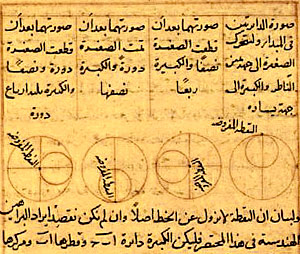
Fourteenth-century copy of a manuscript from Tusi which describes a geometric construction, now known as the Tusi couple.
Tusi's most influential book in the West may have beenTadhkirah fiʿilm al-hayʿa (Treasury of Astronomy), which describes a geometric construction, now known as the Tusi couple, explained by Al-Khalili as "a small circle revolving around the inner rim of a larger circle twice its diameter. The clever feature is that a point on the circumference of the smaller circle will be seen to oscillate back and forth in linear motion along a diameter of the larger circle. By means of this construction, al-Tūsi succeeded in reforming the Ptolemaic planetary models, by doing away entirely with the awkward equants."
Other important astronomers include Ibn al-Shatir, Ali Qushji, Al-Birjandi and al-Khafri. The revolution led to a movement away from the philosophical foundations of Aristotelian cosmology and Ptolemaic astronomy to a greater emphasis on empirical observation and the insistence on the need to employ mathematics to describe and predict planetary positions and nature as a whole.
The Tusi couple, together with the new solar and lunar theories of Ibn al-Shatir, had a decisive impact on Copernicus, who used these mathematical strategies even to the point of employing very similar figures to those used by Tusi in his couple, as well as the Latin equivalents of the Arabic characters. Of course, Copernicus was not the first one to present heliocentricity (the idea that the Earth moved around the sun rather than vice versa); that concept had been around as a fringe idea for two millennia. But Copernicus could not have arrived at his final heliocentric model without the work of the Islamic astronomers at Maragha.
During the most splendid period of Islamic Spain, ignorance was regarded as so disgraceful that those without education concealed the fact as far as possible, just as they would have hidden the commission of a crime. (S. P. Scott, History of the Moorish Empire in Europe, quoted in The House of Wisdom by Jim Al-Khalili)
The Iberian Peninsula – Al-Andalus (750–1031)
"In Al-Andalus, for eight centuries, communities of Muslims, Jews, and Christians lived side by side or intermingled the one with the other. There was no precedent for so extended an experiment in the history of Europe, and it has not been equaled since, for daring, brilliance, or productivity." (Steven Nightingale,Granada: A Pomegranate in the Hand of God, p. 119)
As previously mentioned, in 750 the Abbasids overthrew the Umayyad dynasty in a deadly feud that left the latter facing near extermination. Luckily, 16-year-old Abd ar-Rahman escaped and, with the help of those still loyal to the Umayyads, fled to Spain, where he had Berber relatives on his mother's side. With loyal Umayyad help, he entered Cordoba (formerly Khordoba of the Visigoths) and became its ruler.
Having secured a power base, Abd ar-Rahman I proclaimed himself the first Umayyad ruler of Andalusia and refused to recognize the Abbasid caliphate in Baghdad. However, it was not until the early ninth century, at about the same time as Al-Mamun started his House of Wisdom, that Abd ar-Rahman's great-grandson, Abd ar-Rahman II, set about creating a center of learning to rival Baghdad.
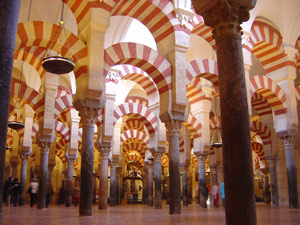
The Great Mosque of Cordoba (image by Timor Espallargas).
Under Abd ar-Rahman and his descendants, Cordoba became known as the "Ornament of the World," the capital of Al-Andalus – or Andalusia, as it is known today. For about a century beginning in 900, Al-Andalus became the most heavily populated area of Europe. Arabic philosophers, trained in the East, migrated there, and schools and libraries flourished. From 912 to 961, Caliph Abd ar-Rahman III reigned as Emir of Cordoba and then as its caliph. His son, al-Hakam, built a massive palace-library complex, the Madinat al-Zahra, near Cordoba, housing half a million books. Hasdai Shaprut, the Jewish polymath, was a prominent advisor, physician and emissary of the caliph, and traveled to Leon to treat the Christian king Sancho. Sephardic Jews engaged in explorations of philosophy and science, and created monumental legal codes and a revolution in poetry. One of the most prominent among them was Samuel ibn Nagrella (993–1056) a medieval Spanish Talmudic scholar, grammarian, philologist, soldier, merchant, politician and influential poet.

The Great Mosque at Cordoba Mihrab (prayer niche that faces the direction of Mecca to which all Muslims pray five times a day). (Image by Ingo Mehling.)
This convivencia of cultures, religions, languages and brilliant minds changed the course of European history. To quote Steven Nightingale again: "It was a culture of preternatural brilliance, with its doctors and astronomers, poets and viziers, scholars, translators, poets, mystics, and mathematicians. … By their work, these men shared the best of the science and philosophy present in one of the most advanced cultures in the history of the Mediterranean: a recent evaluation among historians places Al-Andalus at its zenith no fewer than four centuries ahead of Latin Europe. The texts they translated are a crucial part of the foundation of the Renaissance. It is impossible to imagine the rapid development of the West in science, culture, and commerce without just this gift of knowledge."
Abu al-Qasim al-Zahrawi (936–1013; Latin name Abdulcasis)
Tremendous achievements in medicine were made in Andalusia. Abu al-Qasim al-Zahrawi (Abulcasis) known and The Father of Medicine was the inventor of more than a hundred medical instruments, including the forceps, surgical hook, bone-saw, speculum and syringe. Together with al-Razi's Al-Hawi and Avicenna'sCanon, al-Zahrawi's Kitab al-Tasrif (The Method of Medicine) was one of the main reference books on medicine in Europe during the Middle Ages. In this book al-Zahrawi lists many procedures that he developed, such as a surgical procedure to relieve migraines, and a method to fix a dislocated shoulder, both of which were picked up and developed further by later physicians.
Astronomical achievements in Andalusia included the work of al-Zarqali, who made the first universal astrolabe that could be used anywhere in the world, and who figured out that the orbit of Mercury is oval rather than circular (although he wrongly thought that Mercury orbited the Earth). He is one of only two astronomers named in Copernicus'sDe revolutionibus orbium coelestium (On the Revolutions of the Celestial Spheres.)
Abu l-Walid Muhammad ibn Amad ibn Rushd (1126–1198; Latin name Averroes)
Averroes was a polymath and one of the world's most important philosophers; he argued that religion and philosophy are not incompatible but, on the contrary, work together. "Truth does not contradict truth," he said. Averroes wrote commentaries on all of Aristotle's works, as well as a translation of, and commentary on, Plato's Republic. Averroes' many books were studied in Europe and initiated an intellectual revolution in philosophy, education and theology. Just a few years after his death, the great universities in Paris and Oxford began operation. They were secular and included subjects such as logic, metaphysics, ethics and the natural sciences. Students might go on to study medicine, law or theology, but each of those disciplines had their foundation in philosophy, thanks in part to Averroes.
"Ignorance leads to fear, fear leads to hatred, and hatred leads to violence. This is the equation." (Averroes)
Solomon ibn Gabirol (1028–1058; Latin name Avicebron)
Avicebron was a Jewish philosopher and poet. Among his many works was Fount of Life (Fons Vitæ), a long treatise based upon Sufi illuministic philosophy. Avicebron wrote both sacred and secular poems in Hebrew, the most famous of which was Keter Malchuth (Royal Crown). "Ibn Gabirol, the Jewish follower of the Arab Sufi, exercised an immense and widely recognized influence upon Western thought. … Because he wrote in Arabic, many authoritative Christians of the northern European school, then imbibing 'Arab' learning, thought that he was an Arab. Some at least considered that he was a Christian, 'sound in doctrine,' and they said so. The Franciscans accepted his teachings, which they eagerly transmitted into the Christian stream of thought, having culled them from a Latin translation made about a century after Avicebron's death." (Idries Shah, The Sufis)
In his Fons Vitae, Avicebron asks 'Quare factus est homo? (Why was man made?). He maintains that the goal is to understand the ends or purpose of the human being. A human ought to "pursue knowledge of his final cause [or purpose] according to which he was composed," (Fons Vitae 1.2, p. 4, lines 8–9)
Abu Imran Musa ibn Ubaid Allah ibn Maimun (1135–1204; also known as Moses Maimonides)
"MAIMONIDES" BBC Interviewer Melvyn Bragg is joined by John Haldane, Professor of Philosophy of University St. Andrews, Sarah Stroumsa the Alice and Jack Ormut Professor Emerita of Arabic Studies at the Hebrew University of Jerusalem, and the first woman to serve as Rector of the Hebrew University, and Peter Adamson, Professor of Ancient and Medieval Philosophy, Kings College, London.
Moses Maimonides was a physician and philosopher and is generally regarded as the greatest Jewish thinker of the Middle Ages. By the time of his ninth birthday, the Berber Almohads of North Africa invaded the Iberian Peninsula, bringing with them a more aggressive form of Islam. Their slogan was "No synagogue, no church." Upon the invasion of Al-Andalus, young Maimonides and his family fled from Cordoba to Fez in Morocco and finally ended up in Cairo, then a center of learning. Maimonides eventually became known as the city's leading physician, a clinician whose skills were sought from far and wide. Despite long days spent caring for patients, Maimonides wrote extensively about both medicine and philosophy. His medical works span all topics of clinical medicine and reflect rational thinking and an understanding of the relationship between mind and body. Well known for his philosophical writings, Maimonides tried to present two separate tracks – one for the nation and the other for the individual. Asking how it would be possible to build a righteous nation, he compiled the Mishneh Torah, a code of religious law. But there might be other ways the individual can take towards perfection, he claimed, noting both Moses and Aristotle as examples. In his masterful philosophical work, The Guide for the Perplexed, Maimonides addresses the question of how one can reconcile what science teaches with what religion teaches. He asserted that a lot of scripture is allegorical or metaphorical and refers to the inner truth that God is beyond any science, holding that there is a single God one cannot perceive and can only get close to by understanding what He is not; one cannot say or think anything about God, since nothing is on a par with Him.
"What Maimonides is doing all the time is emphasizing the transcendence of God as the ground of Being, the ground of Knowledge, God's knowledge is the same as Reality. … What we are to do; how we are to perfect ourselves? We are made as images of God, we have intellect, we have will, we are to engage in this imitation of the divine by becoming to the extent that we can godlike, by transforming the world that God has expressed out of his nature back in to mind through our knowledge of it. … So the world is a creation out of mind and is a reception into mind. … We come to perfection in understanding the reality that surrounds us." (John Haldane, Professor of Philosophy of University St. Andrews)
Maimonides influenced the Italian Thomas Aquinas (c.1225–1274) and to this day is considered the topmost Jewish thinker.
The End of the Caliphate and the Christian Reconquest
Besides Spain, there were other pathways of transmission and translation between the Christian and Muslim worlds. Venice traded with the Muslim world for centuries. We owe our coffee habit to the importation of the beverage into Europe from the Arab world by Venetian merchants. Sicily, which in the twelfth century included the entire southern half of Italy, remained as religiously tolerant under Norman rule as it was under Islamic rule. There Hebrew, Arabic, Latin and Greek were recognized as official languages and Sicily's capital Palermo was one of Europe's most important cultural centers.
Despite the decline of Muslim rule in Spain, Arabic works and knowledge spread into Christian Europe. "The irony…was that the intellectual influence of Arabic-based learning and culture…waxed in almost direct proportion to the political waning of what remained of al-Andalus" (Maria Rosa Menocal, The Ornament of the World, p. 194)
The Madinat al-Zahra library was destroyed in 1009, when Cordoba was besieged by the Berbers. The Umayyad caliphate ended in 1031, which led to the formation of multiple city-states, or taifas. The Christian ruler Alfonso VI conquered the taifa of Toledo in 1085, an act that also provoked an invasion from the Berber Almoravids, which Alfonso would spend the remainder of his reign resisting. Mutamid, the last ruler of the taifa of Seville, sought help from the fundamentalist Muslim Almoravids, and for the next 150 years, the taifas came under their control, followed by that of the Almohads – preventing the fall of Al-Andalus to the Iberian Christian kingdoms.
Eventually the Almohads were defeated by Ferdinand III of Castile, with Cordoba falling in 1236, Valencia in 1238 and Seville in 1248. The last Arabic ruler in Spanish territory was Abu abd Allah Muhammad XII (also known as Boabdil) of the Emirate of Granada, who formally gave up his sovereignty and territories to the Crown of Castile in 1492. Under Ferdinand II and Isabella I of Aragon and Castile, Muslims were pushed out of Gibraltar, and conversions to Christianity were forced on Jews and Muslims alike.
The Toledo School of Translators
"Far from being peripheral or secondary to the principal concerns and activities of those who remained speakers of Latin . . . the dominant world of the age in which Arabic was the classical language was rarely out of mind and never out of reach, and the effects of such contacts were widespread and central. They were often the intellectual lifeblood of northern European centers." (Menocal, The Arabic Role in Medieval Literary History)
Were it not for Islamic learning, Western thought would have been limited to fragments patched together by western teachers such as Boethius, Marianus Capella, Bede and Isidore. The works of Plato and Aristotle would have been virtually unknown. Instead, from the tenth century on, European scholars traveled to Spain to study and "Through trade contacts and through political presence in Spain and Sicily the superior culture of the Arabs gradually made its way into western Europe." (Montgomery Watt, The Influence of Islam on Medieval Europe)
Once the taifa of Toledo was under his control, Alfonso VI of Leon and Castile promised the Muslim inhabitants that they could continue their religious practices, though he exacted heavy financial tributes in return. His physician was Granada-born Joseph Nasi Ferruziel, a prominent Jew who owned large estates around Toledo, and for a short while religious tolerance in the region was such that even the church of Santa Maria la Blanca was shared, with Muslims using it on Fridays, Jews on Saturdays and Christians on Sundays.
From 1126 to 1151, some three centuries after the Translation Movement in Baghdad, Archbishop Raymond of Toledo founded Toledo's School of Translators at the city's cathedral to promote the translation of philosophical and religious works from Arabic into Latin.
Ferdinand III's son Alfonso X, known as "the Learned" and "the wise king," reigned from 1252 until his death in 1284. He reoriented the work of Toledo's School of Translators so that it translated works from Arabic into Castilian rather than into Latin, thus laying the foundations for the spread of the modern Spanish language. Alfonso sponsored the creation of the Alfonsine astronomical tables, updating the tables that had been generated in Baghdad and had been translated by Gerard of Cremona from the Arabic. As Nightingale points out in Granada: A Pomegranate in the Hand of God, this was an impressive example of the fruits ofconvivencia, "the work of Arabic astronomers [sponsored by] a Christian king, refined and extended by two Jewish scholars."
In the first quarter of the twelfth century, key locations of translation work included cities in Spain and such as Barcelona, Tarasona, Segovia, and Pamplona. In Sicily Roger II and his son William I preserved Arab and Greek culture and translations from Greek and Arabic into Latin were made by such notable figures as Henry Aristippus, Admiral Eugenius, the monk Filagato Ceramide and Adelard of Bath. Beyond the Pyrenees were translation centers at Toulouse, Beziers, Narbonne, and Marseilles. Eminent translators include Plato of Tivoli, Robert of Chester and Herman of Carinthia with his pupil Rudolf of Bruges; Hugh of Santalla in Aragon, Robert of Ketton in Navarre and Robert of Chester in Segovia.
The Christian European world came face-to-face with the Islamic world in a series of religious wars known as the Crusades. From 1096 to 1291, Christian knights, soldiers and commoners reaching the Islamic world were astounded to discover that the so-called infidels had a more sophisticated and developed civilization than their own. Islamic cities had hospitals, sewers and irrigation; their thinkers seemed more skilled, learned and intelligent than their European counterparts. Islamic scholars such as Montgomery Watt note that the shame this caused accounts for the historical errors and omissions that, until recently, ignored the Arab contribution to Western thought. "Distortion of the image of Islam among Europeans was necessary to compensate them for this sense of inferiority." (The Influence of Islam on Medieval Europe)
Khalili notes that apart from Aquinas and the English William of Occam (c.1288–1347), "there were very few other Christian scholars whose achievements could rival their Muslim counterparts until the end of the fifteenth century and the arrival of Renaissance geniuses such as Leonardo da Vinci. By that time, European universities would have contained the Latin translations of the works of all the giants of Islam, such as Ibn Sīna, Ibn al-Haytham, Ibn Rushd, al-Rāzi, al-Khwārizmi and many others. In medicine in particular, translations of Arabic books continued to be studied and printed well into the eighteenth century. Among the European scholars influenced by their Islamic counterparts before them were Roger Bacon, whose work on lenses relied heavily on his study of Ibn al-Haytham's Optics, and Leonardo of Pisa (Fibonacci), who introduced algebra and the Arabic numeral characters after being strongly influenced by the work of al-Khwārizmi."
Source: https://humanjourney.us/the-spread-of-greek-culture/
0 Response to "How Elements of Ancient Greek Culture Continue in the Western World Today"
Postar um comentário